서 론
된장은 청국장, 간장 등과 함께 콩을 주원료로 한 대표적인 대두발효식품으로서, 곡류단백질에서 부족하기 쉬운 필수아미노산 및 지방산, 유기산, 미네랄, 비타민 등이 풍부하여 영양학적 가치가 높고, 특유의 독특한 향미와 구수한 맛을 가지고 있어 식생활에 기본 또는 부재료로 널리 이용되고 있다(1). 된장은 제조 방식에 따라 콩만으로 메주를 쑤고 소금물을 첨가하여 자연균에 의한 1~5년 장기간 발효숙성 과정을 거친 전통 재래식 된장(2)과 Aspergillus oryzae 등 국균을 접종한 koji를 사용하여 발효과정을 인위적으로 조절하여 잡균의 오염을 차단하고(3) 1년 이내로 발효시키는 개량식 된장으로 대별된다. 최근에는 생활양식의 변화와 핵가족화로 편리성을 추구하는 소비자의 욕구로 인해 전통식 재래 된장보다 공장에서 생산되는 개량식 된장의 수요가 증가되고 있는 추세로(4), 개량식 된장도 소비자의 기호에 맞추어 전통식 방법과 혼용하여 변형시키려는 노력과 다양한 부재료를 첨가하여 맛의 변화뿐만 아니라 기능성을 향상시키려는 연구가 진행되고 있다(5). 그 중 하나로 대두를 주원료로 부재료를 섞거나 또는 특별한 재료로 만든 장 혹은 계절에 따라 별미로 담는 단기장을 의미하는 속성장은 별미장으로도 표현하며 대개 1개월 안에 가식할 수 있어 재래된장보다 빨리 먹을 수 있고 일반 전통된장과는 달리 다양한 부재료를 활용할 수 있어 부재료로부터 얻는 특유의 맛과 기능성 성분을 보강할 수 있다(6). 속성장은 각 지역의 특성에 맞게 단기간 발효시켜 제조되며 된장 및 간장과 구분된다고 알려져 있다. 문헌에 의하면, 장맛과 숙성기간에 따라 기본장(고추장, 된장, 간장) 3종과 별미장 138종으로 구분된다(7). 속성장은 식염 농도가 낮아 다양한 소비계층에 어필할 수 있는 장점을 가지고 있으나 저장성이 낮다는 문제점이 남아있어 이에 대한 보다 다양한 연구가 필요할 것으로 생각된다(8).
귤피는 운향과(Rutaceae)에 속하는 상록 소교목인 귤(Citrus unshiu Markovich)의 성숙한 과식의 과피(Citri pericarpium)를 건조시킨 것으로, 예로부터 메스꺼움, 소화불량, 해수, 가래를 없애주고 이뇨작용에도 효과가 있어 한약재로 사용되어져 왔다(9). 또한 귤피에 함유된 것으로 알려진 플라보노이드 성분인 naringin, hesperridin, nobiletin 및 tangeretin 등은 항산화, 항염증, 항균, 항바이러스, 지질 저하, 암세포 증식 억제 작용 등의 효과가 보고되어져 있어(10,11,12,13,14) 중요한 기능성 소재임이 분명하다. 하지만, 우리나라 감귤 산업은 최근 연평균 생산량이 60만 톤에 이르고 있으나 대부분이 생과 소비에 치우쳐 있어(15), 많은 양의 감귤 과피가 폐기물로 처리되어지고 있는 실정이다. 따라서 본 연구에서는 여러 가지 기능적 특성을 가지고 있음에도 불구하고 대부분이 폐기되고 있는 귤피를 식품소재로 활용하기 위하여 Rhizopus oligosporus와 Aspergillus oryzae로 제조한 코지를 사용하여 속성장을 제조하였으며, 제조한 속성장의 품질특성을 조사하였다.
재료 및 방법
2012년에 생산된 백태를 순창 농가로부터 구입하여 실온에서 20시간 침지시켜 121℃에서 40분간 증자한 다음 40℃로 냉각시켰다. 여기에 콩 무게의 1%(w/w) 비율로 Rhizopus oligosporus(KCCM 11275)와 Aspergillus oryzae(KCCM 60241)를 각각 접종하여 30℃에서 48시간 배양시켜 사용하였다.
백태를 24시간 수침한 후 증자(121℃, 40 min)하여 마쇄하였다. 마쇄한 콩에 보리가루(삶은 콩 무게의 10%), 귤피가루(삶은 콩 무게의 10%), 소금(삶은 콩 무게의 10%), Koji(삶은 콩 무게의 3%)를 넣고 물과 혼합한 다음 용기에 담아 배양기(30℃)에서 30일 동안 숙성시켰다. 이때 사용된 귤피는 2012년 제주도산 mandarine(citrus unshiu, Jeju)으로 대형마트(Jeonju)에서 구입하여 깨끗하게 세척하고, 건조기(70℃±2)에서 2시간 정도 건조시킨 다음 믹서기(HR- 2096, Philips electronocs, Amsterdam, Netherlands)로 갈아서 사용하였으며, 소금은 2012년에 생산된 것으로 전남 신안군 염전을 통해 직접 구입하여 사용하였다.
수분함량은 105℃ 상압건조법, 조단백은 semi-kjeldahl 분석법, pH는 pH meter(Orion 420A, Thermo Scientific, Beverly, MA, USA)로, 산도 측정은 pH 측정 후 0.1 N NaOH 용액으로 pH 8.3이 될 때까지 적정하여 소비된 0.1 N NaOH 용액의 mL값을 된장 10 g당으로 환산하여 적정산도로 나타내었다. 또한, 아미노태 질소 함량은 Formol법, 환원당 함량은 DNS법에 따라 540 nm에서 흡광도를 구하여 glucose 표준곡선을 이용하여 그 값을 환산하였다.
유리당 및 유기산 분석을 위해 시료 5 g에 증류수 45 mL을 넣고 1시간 균질화 시켜 Sep-pak C18 cartridge(Waters Assoc, Milford, MA, USA)와 0.45 μm membrane filter를 통과시킨 다음 HPLC(Shimadzu 20A, Shimadzu Co., Kyoto, Japan)로 분석하였다. 유리당 column은 Shodex Asahipak NH2P-504E(4.6 mm×250 mm)을 사용하여, column 온도 35℃, flow rate 1.0 mL/min, mobile phase는 acetonitrile과 water를 75:25(v/v), injection volume 20μL, 검출기는RI-detector(RID-10A, Shimadzu)를 이용하여 분석하였다. 유기산은 ICSep Coregel-87H3(7.8 mm×300 mm) column에, column 온도 35℃, flow rate 0.6 mL, mobile phase 0.008 M H2SO4를 이용하여 UV detector로 210 nm에서 분석하였다.
시료 1 g을 0.1% peptone수에 10진 희석법으로 희석시킨 다음, 희석액을 총 균수는 Nutrient agar(Difco, Becton, Dickinson & Co., Sparks, MD, USA)에 도말하여 배양(37℃, 24시간)하고, 효모 및 곰팡이는 potato dextros agar(Difco)에서 도말하여 배양(25℃, 2~3일)한 후 colony를 계수하였다.
시료 10 g에 증류수 100 mL를 첨가하여 실온에서 2시간 동안 진탕 추출 후 여과한 조효소액 1 mL에 1% 전분용액 1 mL을 첨가하여 40℃에서 30분간 반응시킨 후 1 M acetic acid 10 mL를 넣어 반응을 중지시켰다. Iodine 용액 1 mL를 가하여 660 nm에서 흡광도를 측정한 다음 효소액 1 mL이 나타내는 흡광도를 효소역가로 표시하였다.
pH 3.0 또는 pH 7.0으로 조정한 0.6% casein 용액 3 mL를 예열(30℃, 2 min)하여 조효소액 1 mL을 첨가시킨 다음 30℃에서 10분간 반응시킨 다음, 0.4 M trichloroacetic acid(TCA) 5 mL를 넣어 반응(30℃, 30 min)을 중지시켰다. 반응이 중지된 여액은 여과하여 여액 2 mL에 0.4 M Na2CO3 5 mL과 Folin reagent 용액 1 mL를 넣어 실온에서 30분간 발색시켜 660 nm에서 흡광도를 측정하고, 효소액 1 mL에서 1분간 1 μM의 tyrosine을 유리할 때를 1 unit로 하였다.
시료 1 g에 70% ethanol 30 mL를 첨가하고 1시간 교반시킨 다음, 원심분리(21,000×g, 15 min)하여 상등액을 70% ethanol 25 mL로 2회 반복 추출하고, 추출액을 합하여 감압 농축하였다. 여기에 0.02 N HCl 20 mL을 가하여 녹이고 10배 희석하여 0.45 μm membrane filter로 여과하여 아미노산자동분석기(Sykam S-4300, Eresing, Germany)로 분석하였다.
향기성분 포집은 AQ-200 liquid sampler(Japen Analytical Industry, Tokyo, Japan)를 이용하였다. 시료관의 온도는 40℃로 설정하고, 50 mL/min의 속도로 시료를 bubbling하여 시료를 휘발시켰으며 휘발된 시료는 Tenax GR 흡착관(Japan Analytical Industry)에 30분 동안 흡착시켰다. 흡착된 시료는 Purge & Trap Sample(JTD-505Ⅲ, Japan Analytical Industry)-GC/MS QP 2010 plus(Shimadzu, Kyoto, Japan)로 분석하였다. 흡착관 내 흡착된 시료는 280℃에서 30분 동안 탈착시키는 동시에 curio pointer(-40℃)에서 재 흡착시키고, 재 흡착이 끝난 후 280℃로 pyrolysis 시켜 column에 주입하였다. 그 외 조건으로 Transfer-line temperature 280℃, needle heater 200℃, cold-trap heater 86 MPa, head press 1.0 mL/min, column flow 1/100, split ratio로 분석하였다. 시료의 분석은 GC/MS QP 2010 plus(Shimadzu), column은 DB-624 column(30 mm×0.251 mm×1.40 mm; Agilent Technologies, Wilmington, DE, USA)를 사용하였으며, oven temperature program은 40℃ for 3 min hold, 10 mL/min up to 260℃, 5 min hold로 분석하였다. 질량분석기의 ion source 온도는 200℃, transfer line은 250℃, EM voltage은 70 eV를 사용하였다. database는 NIST database(Wiley 9.1 v)를 이용하여 정성분석 하였다.
모든 실험은 3회 이상 반복 실시하여 평균(mean)±표준편차(standard deviation, SD)로 표시하고, 시료간 차이는 p<0.05 수준에서 one-way ANOVA를 실시하였으며, Duncan’s multiple range test로 그 유의성을 검증하였다.
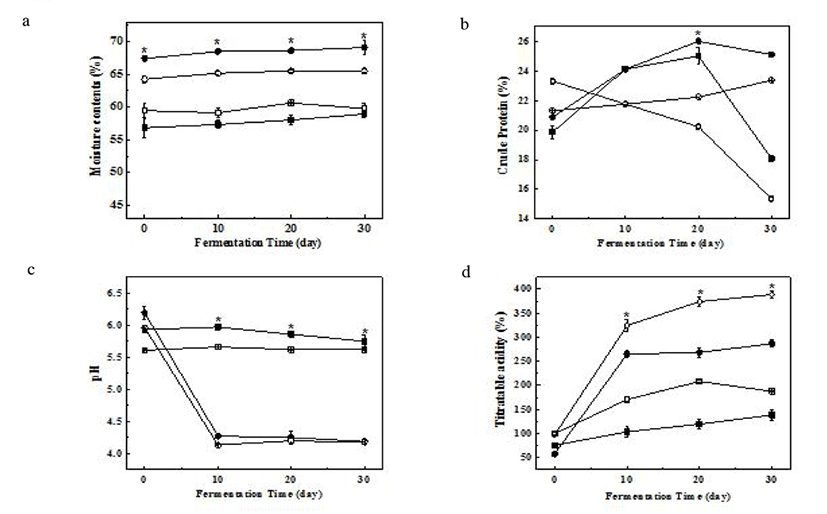
결과 및 고찰
균주를 달리하여 제조한 귤피 속성장의 수분함량은 발효 초기 56.83~67.43%로 발효기간 동안 큰 차이를 보이지 않았으며, Aspergillus oryzae로 제조한 속성장(AS) 및 A. oryzae로 제조한 귤피 속성장(ATS)에서 Rhizopus oligosporus로 제조한 속성장(RS) 및 R. oligosporus로 제조한 귤피 속성장(RTS)에 비해 수분함량이 높게 나타났다(Fig. 1a).
균주를 달리하여 제조한 귤피 속성장의 조단백 함량은 발효가 진행됨에 따라 감소하였고, 특히, RTS의 경우는 다른 실험군들에 비해 조단백 함량이 크게 감소하여 발효 30일째 15.37%로 가장 낮은 함량을 나타내었다(Fig. 1b). 이는 발효미생물에 의해 생성된 단백질 가수분해효소의 작용으로 단백질이 분해되어 초기 발효에서 단백질 함량이 급격하게 감소(16)되기 때문으로 생각된다.
균주를 달리하여 제조한 귤피 속성장의 pH 및 적정산도 변화는 Fig 1c-d와 같다. RS 및 RTS의 pH는 발효기간 동안 큰 변화가 없었던 반면에, AS 및 ATS의 경우는 발효기간 동안 크게 감소하여, 발효 30일째 AS 및 ATS의 pH가 4.19 및 4.79로 발효 초기(pH 6.19 및 5.96)보다 크게 감소하였다(Fig. 1c). 이와 관련하여 균주를 달리한 귤피 속성장의 적정산도는 발효기간이 증가함에 따라 증가하였고, 특히 pH가 낮았던 AS 및 ATS의 적정산도 변화가 크게 나타났다(Fig. 1d). 된장의 pH와 적정산도는 발효과정에 관여하는 미생물의 발효대사와 밀접한 관련이 있어 발효의 지표로 사용된다(6).
균주를 달리하여 제조한 귤피 속성장의 아미노태 질소 함량 변화는 Fig. 2와 같다. 귤피 속성장의 아미노태 질소 함량은 발효 초기 104.74~224.45 mg%로, 저장기간이 증가함에 따라 꾸준히 증가하여 저장 30일에는 247.83~470.64 mg%로 초기 함량에 비해 2배 이상 증가하였다. 균주별로는 AS가 RS보다 아미노태 질소 함량이 높았고, 귤피를 첨가한 속성장의 아미노태 질소 함량 또한 ATS(470 mg%)가 RTS(449 mg%)보다 높았다.
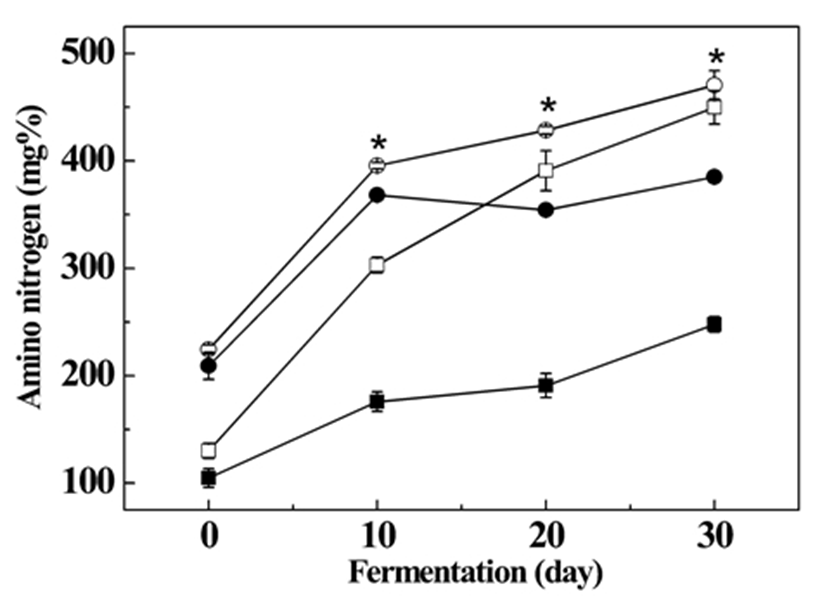
아미노태 질소는 된장 고유의 구수한 맛과 발효정도의 지표로 된장의 제조와 숙성 과정 중에 콩 단백질이 효소작용 등으로 인하여 가수분해되어 맛 성분을 생성하게 되는 것으로 알려져 있다(17). 아미노태 질소 함량은 전통식품 규격에서는 된장 160 mg%, 고추장 150 mg%, 청국장 280 mg% 이상으로 규정하고 있으며, 일반적으로 아미노태 질소 함량이 높은 장류가 좋은 것으로 평가되고 있어 장류제품의 품질규격 상 중요하게 여겨지고 있다(18).
균주를 달리하여 제조한 귤피 속성장의 환원당 함량 변화(Fig. 3)는 RS 및 RTS 모두에서 저장 20일까지 크게 증가한 반면, AS 및 ATS는 저장기간 동안 큰 변화가 없었다. 이는 단기 발효 시, RS로 제조한 속성장은 당질 분해능이 높은 반면, AS로 제조한 속성장은 단백질 분해능이 높은 것으로 나타나 두 균주간의 발효특성 차이를 확인할 수 있었다. 된장의 대부분은 초기 발효에서 환원당 함량이 최고치를 나타내며, 이후 당이 미생물의 영양원, 알코올 발효 및 유기산 발효의 기질로 이용됨 따라 당 함량이 감소하는 것으로 알려져 있다(19)
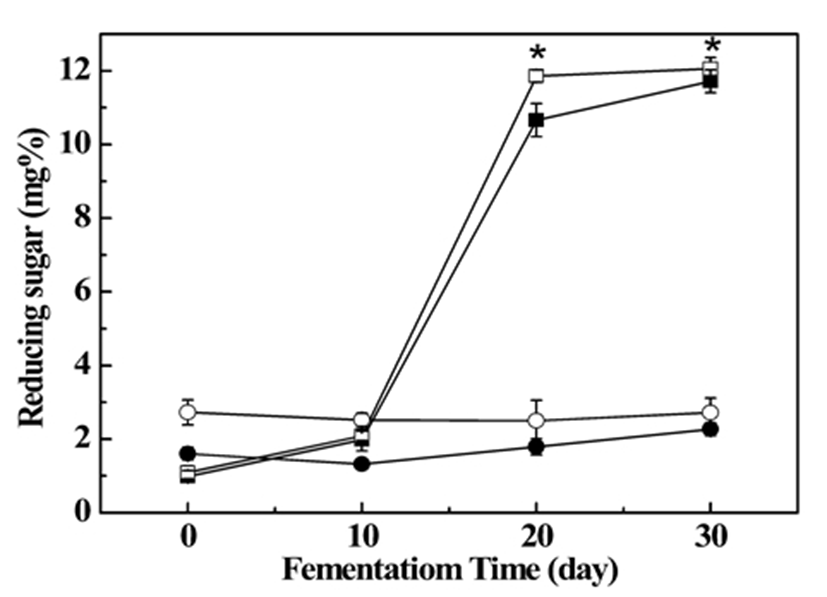
| RS3) | RTS4) | AS5) | ATS6) | |
| Fructose | -1) | 1.54±0.1a2) | - | 2.43±0.1b |
| Glucose | 6.56±0.2c | 4.9±0.4b | 2.92±0.2a | 2.68±0.2a |
| Sucrose | - | - | - | - |
| Maltose | - | - | 1.23±0.1a | - |
| Total | 6.56±0.2 | 6.44±0.4 | 4.15±0.2 | 5.11±0.2 |
1)-, No detection
2)All values are mean±SD (n=3). Mean±SD with different superscript a-d within a row are significantly different (p<0.05) by Duncan’s multiple range test.
3)RS, Soksungjang made from Rhizopus oligosporus koji.
4)RTS, Soksungjang made from Rhizopus oligosporus koji+10% Tangerine peel power.
5)AS, Soksungjang made from Aspergillus oryzae.
6)ATS, Soksungjang made from Aspergillus oryzae+10% Tangerine peel.
균주를 달리하여 제조한 귤피 속성장의 유리당 함량은 Table 1과 같다. 유리당은 저장 30일째 함량을 측정한 것으로 glucose, fructose, maltose가 동정되었고, 그 중 glucose가 속성장의 주요 구성당 임을 알 수 있었다. 총 유리당 함량은 RS 및 RTS(6.44 및 6.66 mg%)가 AS 및 ATS(4.15 및 5.11 mg%)에 비해 높았는데, 이는 α-amylase 활성 차이로 인해 나타난 결과로 판단된다. 또한, 속성장에 귤피의 첨가로 인해 fructose가 동정되었고, 그 함량은 ATS(2.43 mg%)가 RTS 속성장(1.54 mg%)보다 높았다. 이는 귤피의 첨가가 RTS보다는 ATS의 유리당 생성에 더 크게 영향을 준 결과로 생각된다.
균주를 달리하여 제조한 귤피 속성장의 유기산 함량을 저장 30일째 측정하여 나타낸 결과는 Table 2와 같다. 즉, RS의 경우, citric acid, succinic acid 및 acetic acid가 동정되었고, 그 중 acetic acid 함량이 6.70 mg%로 가장 높았던 반면에 AS는 acetic acid 및 lactic acid만이 검출되었고, 그 중 acetic acid 함량이 8.46 mg%로 높았다. 또한, RTS의 유기산은 RS와 마찬가지로 세 종류의 유기산이 동정되었고, 그 중 acetic acid의 함량은 10.25 mg%로 RS에 비해 높았으며, ATS는 AS와 달리 succinic acid 대신 citric acid(0.57 mg%)가 동정되었고, 그 중 acetic acid 함량은 AS에 비해 감소한 반면, lactic acid는 5.57 mg%로 AS(4.02 mg%)에 비해 높았다. 재래식 된장의 유기산 분포는 lactic acid, acetic acid, citric acid, oxalic acid, formic acid, succinic acid, propionic acid의 양상을 보이며, 개량식 된장의 경우는 citric acid, acetic acid, lactic acid, oxalic acid, succinic acid, formic acid로 유기산이 분포되었다고 보고된 바 있다(20).
1)-, No detection.
2)All values are mean±SD. Mean±SD with different superscript a-c within a row are significantly different (p<0.05) by Duncan’s multiple range test.
3)RS, Soksungjang made from Rhizopus oligosporus koji.
4)RTS, Soksungjang made from Rhizopus oligosporus koji+10% Tangerine peel power.
5)AS, Soksungjang made from Aspergillus oryzae.
6)ATS, Soksungjang made from Aspergillus oryzae+10% Tangerine peel.
균주를 달리하여 제조한 귤피 속성장의 총균수(Fig. 4)는 모든 속성장에서 저장기간 동안 꾸준히 증가하다 저장 20일째를 기점으로 감소한 반면에 ATS는 저장 10일 이후 총균수가 크게 감소되었는데, 이는 귤피의 첨가가 ATS의 총균수 성장을 억제하였을 것으로 생각되며, 실제로 귤피의 성분들이 E. coli, A. niger 등과 같은 미생물에 대해 항균효과가 있음이 보고되어져 있다(21,22).
균주를 달리하여 제조한 귤피 속성장의 효모 및 곰팡이 수(Fig. 5)는 RS의 경우, 저장 20일까지 효모 및 곰팡이 수가 꾸준히 증가하다 이후 감소한 반면, AS의 효모 및 곰팡이 수는 저장기간 동안 감소하였다. 또한, RTS의 효모 및 곰팡이 수는 저장 10일 이후 감소한 반면, ATS의 효모 및 곰팡이 수는 저장 20일까지 증가하다 이후 감소하는 경향을 나타내었다. 이와 같은 결과는 제조된 속성장들의 수분함량 등이 영향을 주었을 것으로 판단된다.
균주를 달리하여 제조한 귤피 속성장의 발효 중 α-amylase 활성을 측정한 결과는 Fig. 6과 같다. RS의 α-amylase 활성은 발효 초기 38.29 unit/g로 발효가 진행 될수록 증가하여 발효 30일째 63.47 unit/g이었다. 반면에, AS의 α-amylase 활성은 발효 초기 34.02 unit/g이었으나, 발효 30일째 30.58 unit/g으로 발효기간 동안 큰 변화가 없었다.
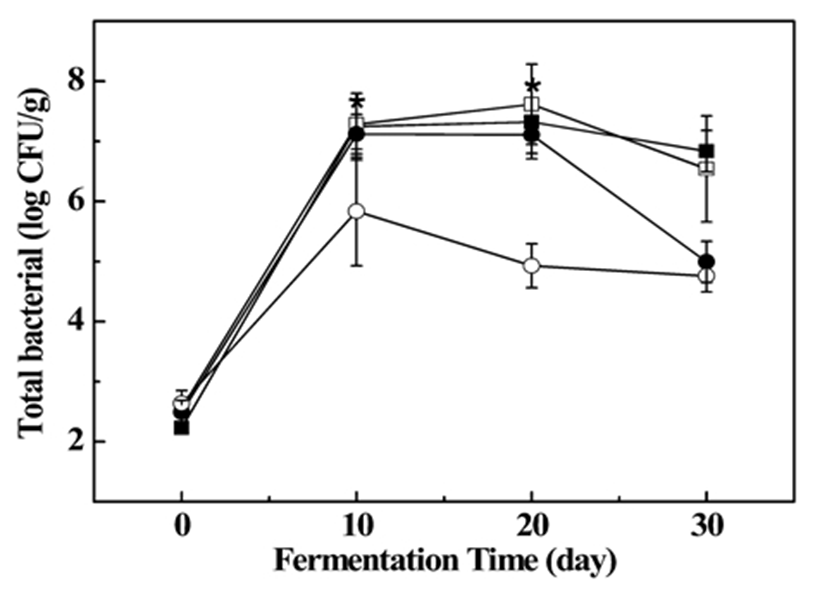
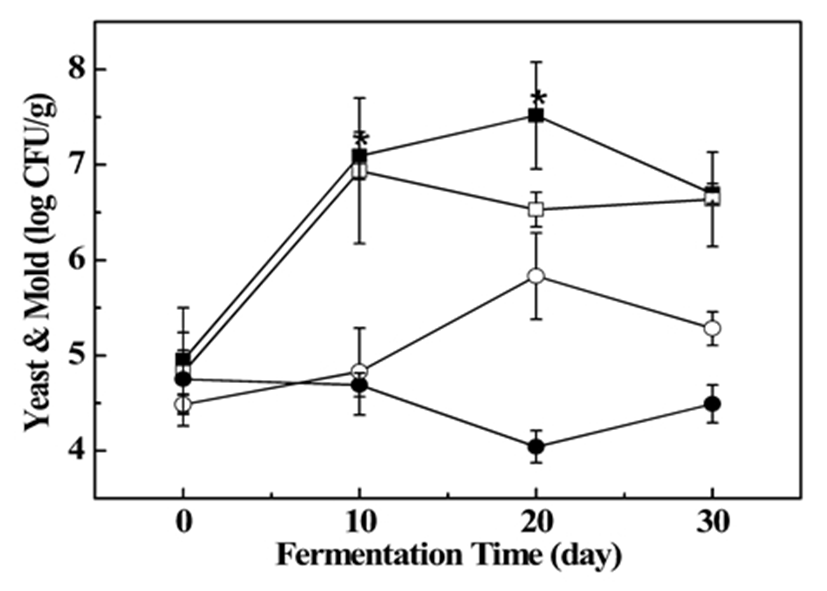
이는 AS의 수분함량이 높고 이로 인한 미생물 생장 저해 등으로 인해 효소활성에도 영향을 주었을 것으로 판단된다. 또한, RTS의 α-amylase 활성은 발효 초기 33.12 unit/g로 발효가 진행될수록 증가하여 발효 30일째 61.17 unit/g이었으며, ATS의 α-amylase 활성은 발효 초기 35.65 unit/g, 발효 10일째 49.40 unit/g으로 가장 높았다가 이후 큰 변화가 없었다. 이는 발효 10일 이후 낮아진 pH 농도에 의해 효소활성도가 저해되었을 것으로 판단된다. 일반적인 된장의 α-amylase 활성은 발효 초기 원료에 함유된 탄수화물이 α-amylase의 기질이 되어 효소활성이 높았다가 발효가 진행되면서 서서히 원료의 전분질이 감소되어 α-amylase 활성이 낮아진다고 보고된 바 있다(23).
균주를 달리하여 제조한 귤피 속성장의 protease 활성을 측정한 결과는 Fig. 7과 같다. 즉, AS가 RS보다 발효기간 동안 protease 활성이 높았다. 또한, 귤피를 첨가한 속성장이 대조구보다 protease 활성이 높았는데, 발효 30일째 RTS의 protease 효소활성은 24.54 unit/g, ATS는 20.14 unit/g으로 RTS의 protease 활성이 높았다. Mok 등(24)은 저염 된장의 protease 활성이 발효 초기 완만하게 증가하다가 발효 2~3주부터 약간 감소하여 7~10주 이후 약간 증가한다고 보고한 바 있다. 된장의 protease 활성은 단백질을 분해하여 구수한 맛 성분을 생성하고, 된장의 숙성 정도를 나타내는 유리 아미노산 함량에도 영향을 주는 것으로 알려져 있다(25).
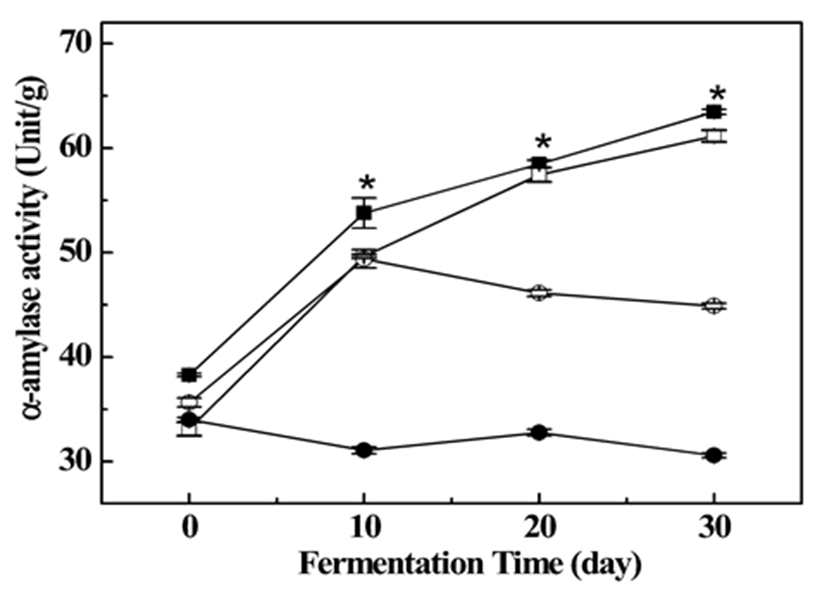
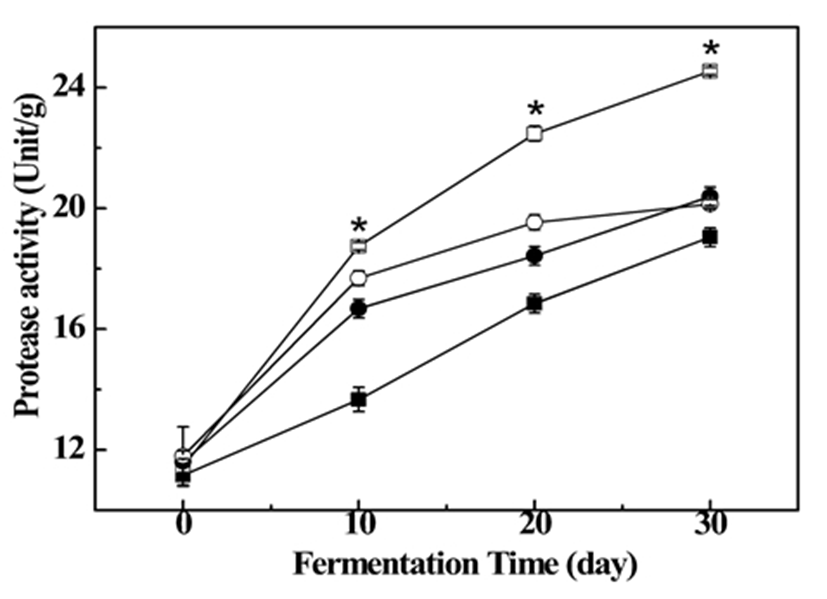
균주를 달리하여 제조한 귤피 속성장의 유리아미노산의 함량 변화는 Table 3과 같다. 저장 30일 동안 총 유리아미노산 함량은 크게 증가하였데, RS의 경우는 lysine, arginine, leucine 등이 높았고, AS는 glutamic acid, lysine, leucine 등의 순으로 높아 균주에 따른 유리아미노산의 차이를 확인할 수 있었다. 또한, RS와 AS에 귤피를 첨가함에 따라서도 유리아미노산의 함량 및 성분에도 차이를 보였는데, RTS의 경우가 ATS보다 총 유리아미노산의 함량이 높았고, 구성성분으로는 RTC의 경우, glutamic acid, arginine leucine 및 lysine 등의 순으로 나타났으며, RS에서는 소량 검출되었던 glutamic acid가 귤피의 첨가로 크게 증가한 것을 확인할 수 있었다. ATS의 유리아미노산 구성성분으로는 arginine, lycine, leucine 등의 순으로 나타났으며, 귤피 첨가로 인해 arginine의 함량이 크게 증가되었음을 확인할 수 있었다. 된장의 숙성과정 중 효소작용으로 인해 원료 단백질로부터 생성되는 유리아미노산은 된장의 맛에 영향을 미치는데, 맛에 대한 기여도는 쓴맛 성분인 leucine과 isoleucine이 가장 큰 영향을, 그 다음으로 cystine, aspartic acid 및 glutamic acid와 같은 구수한 맛 성분이 영향을 미친다고 보고되어 있다(26). 이러한 장류의 유리아미노산의 함량과 조성의 차이는 종균의 사용 여부와 종류, 원료 배합, 발효기간 및 조건에 기인하는 것으로 알려져 있다(27). 따라서 본 실험에서도 각 균주별 귤피 첨가에 따른 유리아미노산의 함량 차이는 속성장 제조 시 사용된 원료에서 기인된 결과로 생각되어진다.
균주를 달리하여 제조한 귤피 속성장에서 분리된 향기성분과 그 함량은 Table 4와 같다. 귤피 속성장에서 동정된 향기성분은 총 60여개로 1-octen-3-ol 등을 포함한 alcohol류가 21개, hydrocarbon류가 14개, ester류 5개, 그 외 acids류, ketone류, aldehyde 등이 확인되었다. 균주별로는 AS가 RS에 비해 2배 이상 많은 향기성분이 동정되었고, 동정된 성분으로는 AS에서 hydrocarbon류, alcohol류 및 ketone류 등의 다양한 성분이 분리된 반면 RS의 경우, alcohol류가 주된 성분이었고 그 외 ketone류 등이 분리되어 AS에 비해 분리된 성분이 적었다. 또한, 속성장에 귤피를 첨가함으로 인해 L-limonene, L-linaool, alphe terpneol 등의 성분이 분리되었는데, 이들 성분들은 감귤류나 포도주, 사과류 등에서 생성되는 것으로 알려져 있다(28).
된장에서 이미 보고된 향기성분으로는 2(3)-methyl-1- butanol, 1-octen-3-ol, 2-furfuryl alcohol(29), trimethylprazine, tetramethylpyrazine 등이 있으며, 2-ethyl-6-methylpyrazine은 miso와 natto의 향기성분으로 보고된 바 있다(29,30,31). 이들 중 3-methyl-1-butanol은 된장의 대표적인 냄새 물질로, 1-Octen-3-ol은 증자대두의 풋내, butanoic acid는 쿰쿰한 불쾌취의 원인물질, 2-penthylfuran은 산패취, benzenacetaldehyde는 고린 향의 원인물질로 알려져 있는데, 속성장에 귤피를 첨가함으로 인해 그 함량이 감소하거나 검출되지 않아 된장 특유의 불쾌취가 크게 감소됨을 확인하였다.
요 약
균주를 달리하여 제조한 귤피 속성장의 수분함량은 발효기간 동안 큰 차이를 보이지 않았으며, 조단백 함량은 발효가 진행됨에 따라 감소하였고, pH는 RS 및 RTS는 발효기간 동안 변화가 없었던 반면, AS 및 ATS는 발효 10일째 크게 감소하였다. 이와 관련하여, 적정산도는 모든 속성장에서 발효기간 동안 증가하였다. 균주를 달리하여 제조한 귤피 속성장의 주요 유리당 및 유기산은 각각 glucose와 acetic acid로 확인되었다. 아미노태 질소 함량은 AS 및 ATS가 RS 및 RTS보다 높은 반면, 환원당은 RS 및 RTS가 AS 및 ATS보다 높았다. 미생물 수는 RS 및 RTS에서 꾸준히 증가하다 감소한 반면, AS 및 ATS는 10일 이후 감소하였다. 효소활성의 경우, RS 및 RTS는 α-amylase 활성이, AS 및 ATS는 protease 활성이 각각 높았다. 주요 유리아미노산으로는 glutamic acid, lysine, leucine 및 arginine 등이 동정되었다. 향기성분 분석결과 총 60여개의 성분이 확인되었는데, 1-octen-3-ol 등을 포함한 alcohol류가 21개, hydrocarbon류가 14개, ester류 5개, 그 외 acids류, ketone류, aldehyde 등이 확인되었고, 3-methyl-1-butanol 등을 포함한 된장의 냄새물질이 귤피의 첨가로 감소된 것을 확인하였다. 이상의 결과를 통해 R. oligosporus는 당류 분해능에, A. oryzae는 단백질 분해능에 적합함을 확인하였고, 귤피의 첨가는 된장의 향미나 식미 등의 관능적 요인에 도움이 될 것으로 생각된다.